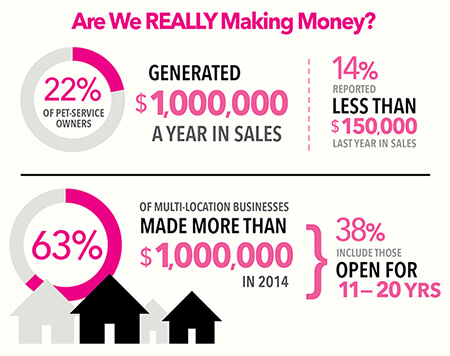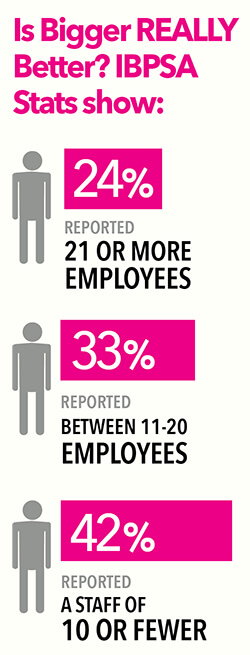
You've Got Tail: The State of the Pet Boarding and Daycare Industry
By Carmen Rustenbeck
Last year, pet boarding and daycare facilities faced an onslaught of challenges from canine flu to historic flooding to organized online competition from uncertified pet sitters. Daycare went mobile as pet boarding trailers — some certified, some not — camped out in shopping mall parking lots, offering to take care of pets while owners hit the stores.
Pet care nightmare stories once again made the national news as the negligence of some pet care service providers maligned an entire industry that safely cares for millions of furry family members every day. Not widely covered, of course, were the positive stories of pet boarding facilities that took in homeless pets and helped their fellow pet care service providers wiped out by weather catastrophes.
As an industry projected to add at least 10,000 jobs and experience at least 15 percent growth in employment over the next five years (see CareerBuilder study released June 4, 2015), pet care services are undeniably hot. Our already multi-billion dollar industry continues to grow with all paws pointing to it only getting bigger as pet parents worldwide continue to spend big bucks on precious family pets. But with virtually no standards, or regulatory thresholds, and the possibility to open a “pet care business” on a shoestring, our industry is now at a crossroads as we face the monumental, but necessary, task of self-regulation.

Are We Really Making Money?
The big, showy statistics continue to confirm we’re a multi-billion dollar industry, but when you’re on your hands and knees cleaning up after a pet, it may not feel so ritzy. Are any of us really making money in pet boarding and daycare?
From April 26 to May 27, 2015, the International Boarding and Pet Services Association (IBPSA), in conjunction with business consultant Crystal Canine, commissioned Researchscape to conduct an online financial survey of pet care service business owners. The industry as a whole is making billions, but what about businesses, individually?
Highlights of the survey of 193 pet care service businesses, and comprised primarily of American businesses, include:
- Pet-services owners may not be millionaires, but they can generate a million dollars a year in sales; 22% bring in that much. On the other end of the spectrum, 14% reported that their business brought in less than $150,000 last year. The median annual revenue was $300,001-$500,000.
- In 2014, 63% of multiple-location businesses made more than $1,000,000. Those keeping with the seven-figure revenue include the businesses that have been open for 11-20 years, a total of 38%.
- The average owner compensation was $101,353 with a median of $72,000. Maximum compensation reported was $450,000.
Based on the survey, for the most part, there is money to be made in the industry but, looking at the data, it may take some time to get there. The survey also showed that 20% of business owners reported that they made less than $75,000, with 12% making less than $40,000, and 5% showing no income at all. If your business resides somewhere in these stats, where do you go for help? How do you get to that statistical median annual revenue of $300,0001 - $500,000?

Is Bigger Really Better?
When You’ve Got Mail made its debut in 1998 it tackled – in a sweet rom-com kind of way – the perceived impending demise of the mom-and-pop bookstore as book mega-chains muscled in. Of course, since then, many of those mega-stores have become empty boxes as online book sales have soared. Not surprisingly, multi-location pet boarding and daycare facilities are increasing as pet care business grows. These facilities have already established reputations and expanding to additional locations, carrying the brand forward, is a natural progression. But what about the mom-and-pops? Is the smaller, single location a dying breed?
Based on a recent survey of IBPSA members, and our daily interactions with members, mom-and-pops are definitely alive and kicking. Our recent member survey indicated approximately 24 percent of our members have 21 or more employees, 33 percent have between 11-20 employees, and 42 percent have a staff of 10 or fewer. While online services and big franchises may grab the headlines, the small business owner is quietly succeeding. As long as service, care, and trust remain at the forefront, increasingly educated consumers and their “furbabies” will give their service to those pet care facilities consistently delivering quality performance no matter what the size of the business.
Quality, not size, is what will ultimately set apart any business and result in increased customer referrals. Pair that with getting educated on the financial side of your business – understanding true cost of services, reducing insurance premiums by educating your staff, effectively branding and marketing your business – and, if you’re not already there, you’ll see that statistical median annual revenue soon. Online successes such as Rover.com should encourage us all to up our business game.
The “Amazoning” of Pet Care?
Returning to our You’ve Got Mail example, after Meg Ryan, Tom Hanks, and Brinkley (the dog) share a sweet embrace and the camera pans to a cotton candy sky, what happens to the imaginary Fox Books? In reality, enter Amazon.com, the age of online book sales, and shuttered Borders bookstores. With the advent of online booking of uncertified pet sitters, is our industry now entering our own Amazoning era with marketing companies such as Rover.com?
The answer, to a great extent, is yes. But we should not fear this new era of marketing and advertising but, rather, find a way to access the wealth of reach it provides for the professional pet care facility. To paraphrase the “Four Actions Framework” offered by W. Chan Kim and Renee Mauborgne in their book Blue Ocean Strategy, we need to consider:
- What should be eliminated?
- What should be reduced?
- What should be raised?
- What can be created?
Perhaps what can be eliminated is the way we have always done it. The industry is experiencing a change when we can integrate fresh ideas and set industry benchmarks. What could be reduced is the offering of services that outweigh the benefit/value to the customer, and/or the bottom line. Pet care is a business – a business with heart, to be sure – and we need to treat it like it’s a business. Let’s educate ourselves in the understanding of margins and break-even points and apply smart financial thinking to pet care. What should be raised is a new standard of pet care, no matter what size you are or how you market to your customers. What is then created is limited only by your imagination. Know your customers, build trust, provide the best consistent service and care and they will choose you every time.
Self-Regulation and the Rise of the Certifiably Educated Pet Care Professional
Ever download a .99 cent book from Amazon? While some are undeniable page turners, more often than not, one page in and the reason it was a .99 cent downloadable book is clearly manifest. The reason “you get what you pay for” is an age-old adage is because it tends to hold true. But when you’re just out of pocket .99 cents, getting what you pay for is probably met with a shrug and a delete, but when you’re talking about the life of a furry family member it’s not quite so simple.
As more people enter this industry with no training and minimal financial risk, the odds of more pet tragedies feels sadly inevitable, and, like it or not, it’s now our responsibility to not only educate ourselves, but educate pet parents as well, and get serious about self-regulation by participating in certification programs for staff and facility.
As more part-time, uncertified pet care providers offer their services, it is the responsibility of professional pet boarding and daycare facilities to raise the bar to not only help protect the lives of furry family members, but to get serious about the business-side of pet care. By making a commitment to the education of ourselves and pet parents, we can continue to grow and thrive and get something even better than a sweet rom-com movie ending — an industry comprised of professionals knowledgeable in pet safety and in creating and maintaining successful businesses that will secure their financial future.
Carmen Rustenbeck, Executive Director of the International Boarding and Pet Services Association (IBPSA), has been involved in non-profit work for over 20 years and active in the pet care industry since 2004. Carmen is committed to building a member-centered organization that promotes the best practices and strategies for helping our industry reach its full potential for the safety of pet clients and staff, and for the financial future of our members. For more information, visit www.ibpsa.com.


